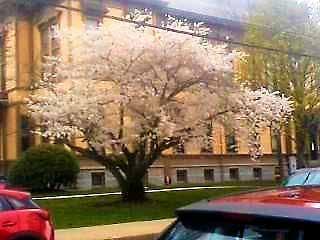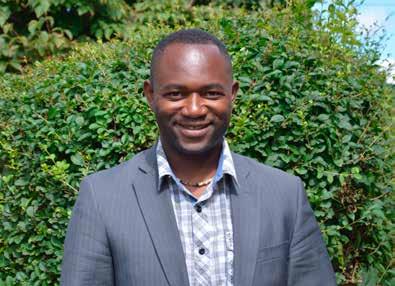
13 minute read
What British rock band appeared in the film “Mrs. Brown, You’ve Got a Lovely Daughter”?
THE SAUGUS ADVOCATE – Friday, April 24, 2020 Saugus gardens in the pandemic
What’s blooming in town this week to make your walks more enjoyable
Advertisement

By Laura Eisener
Spring is here, no matter what! As people are walking around their neighborhoods more than usual, they are noticing things blooming in their neighbors’ gardens that other years might have been just a colorful blur they pass in their cars. Can you find all of these trees in your neighborhood?
Most abundant all over Saugus right now is the familiar yellow blooming shrub forsythia, also known as Golden Bells, Easter tree, and in Chinese as Lián Qiáo. Named after Scottish botanist William Forsyth, the forsythia we most often see is a hybrid between two Chinese species. It is actually used in traditional Chinese medicine, although scientific basis for its use is minimal. People who have seen the 2011 movie “Contagion” may recall that forsythia was touted as a quack cure for the disease in the movie. Forsythia is related to lilacs and privet in the Olive family, but unlike them it blooms before its leaves come out.
April 24 (today) is Arbor Day so it seems most appropriate that we are looking up and appreciating the trees in town. Trees in bloom now include many members of the rose family, such as flowering cherries, plums and pears.
There are several species of cherry, including some very popular weeping varieties which may have white or pink flowers. The white blooming ones, “Snow Fountains,” had their flowers a bit camouflaged by the snow this week. In Cliftondale Square the island in the rotary has two kinds of cherry, a pink weeping cherry and a Yoshino cherry, both at their peak of bloom now.
The white flowering Bradford pear, which was one of the most widely planted public trees in the 70s-90s, is seen in every neighborhood on street sides and parking lots. There are so many in bloom now where Lynn Fells Parkway meets Route 1 that I call it Pear Corner. Besides the ones planted at Kelly’s, Target and North Shore Bank, there are a few that seem to have seeded themselves beside the overpass. When their bloom time ends, a good breeze will give us a “petal flurry” as the petals fall.
Quite a few backyards and the island in Saugus Center, where the Civil War Monument is, have specimens of flowering plum. The tiny flowers are usually very pale pink, and in some varieties white, but you can usually see the burgundypurple foliage just starting to come out as the flowers go by.
Magnolias are just finishing up their flowering season. Most common are the pink and white saucer magnolias, but there are also a number of narrow-petaled white and occasionally pink star magnolias. Just a little later come some yellow flowering magnolias and the deep pink liliifloras, which may have leaves beginning to develop around the same time. These are all Asian species – not until June might we see, or probably first smell, the small blossoms of the native sweetbay magnolia, which gave the village of Magnolia in Gloucester its name. Since the flowers are less visually showy, they have not been as popular in gardens.
Big old wind-pollinated willows may not have petals, but the bright yellow green of the pollen in its catkins make weeping willows some of the most glowing color of the month of April. No longer as abundant as the pears and cherries, these trees really stand out on a gray day because of their size and their nearly neon color at this time of year.
Editor’s Note: Laura Eisener is a landscape design consultant who helps homeowners with landscape design, plant selection and placement of trees and shrubs, as well as perennials. She is also a member of the Saugus Garden Club and offered to write a series of articles about “what’s blooming in town, since so many people have taken to walking the streets in their neighborhoods as a way to get some exercise and get out of the house!” ing voted unanimously, per the recommendation of Town Manager Crabtree, to support a two-year construction moratorium on multifamily dwellings. This reactionary vote validated how poor the initial implementation of projects built under this bylaw was. With that said, I don’t believe a complete overhaul of the zoning bylaw is necessary, but a few targeted tweaks could significantly improve its effectiveness.
Q: How long have you been working on these proposed Article amendments?
A: I’m constantly brainstorming ways to improve our town through the lens of an architect, both bold and subtle, so as a result, I am looking at our zoning bylaw quite often, and not only the BHSD zoning overlay. While I’ve been active in monitoring the BHSD zoning issue for almost three years, I only began drafting the amendments after November’s election. After the holidays, I began to confer and collaborate with colleagues and constituents to revise, reword and ultimately solidify these petitions. Then the time comes to get the signatures and this pandemic happened. Luckily, I was able to carefully and safely secure the signatures needed to submit the Articles to be presented at the Annual Town Meeting, whenever that may be in whatever medium.
Q: Who did you confer with in your research? At last week’s selectmen’s meeting you mentioned you had talked with a former town economic development director and the chair of the Planning Board. What’s the best advice you got from them?
A: As I said earlier, the #1 tenet I set for myself as an elected official was to keep an open mind and work with anyone in town government. Fostering a collaborative environment is where the best work is done. Therefore, I intended to make this as collaborative of a process as possible, and I feel the community members I spoke with was as diverse of a crowd as I could have hoped for to ensure the vetting of these Articles was comprehensive in nature. In this process I reached out, met with or asked feedback from Planning Board Chair Peter Rossetti, former Economic Development Committee Member and contributor to the BHSD bylaw Peter Manoogian, Fellow Precinct 2 Town Meeting Members Bob Camuso, Bill Moore and Chris Riley, all five Board of Selectmen, Town Manager Scott Crabtree, Town Planner Alex Mello, dozens of residents and former Economic Development Director of Saugus Bob Luongo. I also consulted various members of the architecture and planning communities, including two colleagues who sit on planning boards in Wakefield and Watertown, respectively, to get impartial, objective feedback on how other towns regulate zoning and what has been successful.
I think the most informative and helpful conversation I had was with Mr. Luongo, who Mr. Manoogian suggested I contact as he and Mr. Luongo were involved in the original drafting of the bylaw. Both individuals are extremely well versed in zoning and municipal law, and I greatly appreciate them both lending their expertise on this issue. We primarily discussed the “correct” ratio of residential and commercial use as it relates to development on Route 1. We methodically browsed through the pros and cons of regulating a percentage, what the percentage was based on and the feasibility from a municipality’s and developer’s point of view. The discussion really helped me formalize the language in my petitions as well, especially being my first ones I’ve written as a Town Meeting member.
Q: What did your research show that pointed to the need to make improvements to Article 21?
A: I’ve studied and seen for myself numerous successful examples of mixed-use development on and off highway strips in both Massachusetts and in my travels across the United States. The question I kept asking myself is Where did we go wrong as a town and what can we do to fix it?
While there are certainly known factors in town as to why development on Route 1 has been relatively unsuccessful thus far, such as a lack of a Master Plan and having long vacant positions in the Planning and Development department, it’s very important that we look at local precedent. What’s been successful in these communities and why? One frustrating thing for me in my short tenure in Town Meeting has been that in the many conversations I’ve had, many fail to leave the Saugus “bubble.” If there’s no example present in Saugus, it may as well not exist.
I’ve researched what Wakefield is doing, what Lynnfield is doing, what Melrose is doing, etc. I spoke with elected officials and constituents who all unanimously agree that some sort of amendment needed to be made to Route 1’s zoning. I consulted architecture and planning professionals. I wanted to ensure the amendments I planned to propose were not unprecedented. I found that there are plenty of precedents in what I am proposing and that these tweaks in the BHSD bylaw could help preserve and enhance the Route 1 corridor considerably.
AN ARBOR DAY SALUTE: If you happen to be walking in Saugus Center today (Friday, April 24, Arbor Day), take some time to stop and admire the pink Yoshino cherry on the grounds of Saugus Town Hall, facing Hamilton Street. (Courtesy photos to The Saugus Advocate by Laura Eisener) MOST ABUNDANT ALL OVER SAUGUS: Right now the familiar yellow blooming shrub is a common sight. Here’s a nice planting of forsythia at 200 Walnut St. at the corner of Walden Pond Avenue.
ASKS | SEE PAGE 11 ASKS | from page 5
The world is a small village – experiencing COVID-19 across the world Special to The Advocate



In his day-to-day life, Olivier Che works as a registered nurse with Adult Foster Care of the North Shore (AFCNS). He spends his days assisting clients with disabilities and chronic illnesses and their caregivers across Essex County. But when he recently left on a longawaited trip to visit family in his homeland of Cameroon in Africa, Olivier had no idea how much the world would change as COVID-19 hit full force.
As Olivier travelled across three continents in early March, it became clear to him how small the world has become with the movement of people from one place to another. Before he left the USA, there were less than 300 declared cases of COVID-19, and very few cases in the Boston area. For most Americans, it was still business as usual, although school systems were just beginning to announce closures.
His first flight left Boston and arrived in Paris. The airport was not busy, but flights were still arriving in and departing from Paris. With a one-hour layover, he confined himself to a small corner chair that he disinfected with the Clorox wipes given to him by one of the AFCNS caregivers he works with – a welcomed gift since by that point hand sanitizer and other supplies were getting hard to find.
From Olivier’s viewpoint, COVID-19 was not being taken seriously in Paris, at least at the airport, even though there were high numbers starting to be reported in France and Italy. Passengers were not screened, no questions asked. The plane from the USA to Paris was halfempty, which luckily enabled the passengers to spread out.
The next plane he boarded, from Paris to Cameroon in Africa, was full of travelers leaving Europe for a warmer climate. Upon arrival in Cameroon, all passengers were given questionnaires asking whether they were experiencing any signs or symptoms of COVID-19. Each passenger’s temperature was taken with a scan thermometer. Only two cases of COVID-19 had been reported in mid-March, but that went up to 124 by the end of the month.
In Cameroon all schools had been closed, and bars and restaurants were required to close at 6 p.m. Social distancing was not quite as strict…no more than four people in a five-seater car and public transportation was restricted to half capacity. People were advised to stay home.
Cameroon air space soon closed – no flights getting in or out of the country. The U.S. State Department made arrangements for one flight to D.C., and the flight immediately filled up, leaving thousands of Americans stranded in Cameroon. One U.S. Embassy staffer told Olivier how surprised the staffers were at how many Americans were in Cameroon. He was also told that staffers were surprised that people wanted to leave a lowrisk area (Africa) for a high-risk area (the USA). Olivier could not make the flight back on March 30; however, the embassy had promised to get everyone back to the USA.
While in Cameroon, Olivier was able to observe the steps Cameroon’s government was taking to battle COVID-19. The Cameroon Ministry of Public Health’s campaign to deal with the COVID-19 outbreak included installing public handwashing stations equipped with soap, water and hand sanitizer throughout the country. These handwashing stations are free and available to the public. Businesses are required to have staff and customers use them, and the general public is obliged to wash hands before entering stores. Using his training as a nurse, Olivier stepped up to volunteer and teach residents proper handwashing techniques.
Olivier finally made it home to the USA this past week. After recounting his experience, he surmised, “The world is a small village, wash your hands frequently. The world is a small village, stay home. The world is a small village, avoid touching your face. The world is a small village, listen to the local authorities for updates. The world is a small village, stay safe.”
Olivier Che demonstrated proper handwashing technique in Cameroon in Africa. Olivier Che demonstrating proper handwashing technique in Cameroon. A valuable commodity for traveling these days
Q: Do you have any longrange outlook on what needs to be done to address traffic concerns along Route 1 and what the future holds for the town’s major economic corridor?
A: The Route 1 corridor and its adjacencies must be looked at holistically, so we understand how individual developments affect the whole. A functional Planning Department could undertake this effort to brainstorm ideas on how to effectively manage traffic flow in collaboration with MassDOT, identify potential infrastructural improvements and manage growth.
During his three-year tenure as Economic Development Coordinator from 2013-2016, Mr. Luongo was doing some exceptional work and made noticeable progress aimed to push Saugus forward from a planning and economic perspective. We were lucky to have him, and it was sad to see him go. His resignation was understandable as he moved on to Weymouth, which has a team of eight people working for him in the Planning and Community Development department. A department of this magnitude is something I strive for Saugus to invest in the future. It’s not a want, it’s a need.
To give my perspective, there’s really no perfect solution to completely mitigate the traffic on Route 1. There is an increase of commuters to and from the city annually. Route 1 funnels traffic from Interstate 95 and Route 128. Communities located on those thoroughfares continue to grow at a rate even faster than we are. There is also limited space to expand the width of Route 1. While there are certainly some who would prefer to abolish the BHSD zoning district, I feel that would be a large step backwards for the town as it would hinder our ability to adapt Route 1 to what towns and cities of the 21st century need and impede our economic growth long term.
A few things I would investigate is the status of MassDOT projects that address bottlenecking, most prominently the stretch of highway from Route 60 to Route 99, which has been an active MassDOT proposal for 13 years with no action or update. The other two obstructions that would fall under MassDOT scope would be the Lynnfield tunnel and traffic light in Peabody. If we can improve these conditions, which admittedly would be quite costly state projects, it would go a long way towards traffic mitigation in the Saugus portion of Route 1. While I wouldn’t hold my breath waiting for an immediate response from the Commonwealth, we need to advocate that improving these conditions are necessary not just for Saugus, but all communities Route 1 serves.
I would also push to collaborate with the MBTA to service ASKS | SEE PAGE 14 ASKS | from page 10










